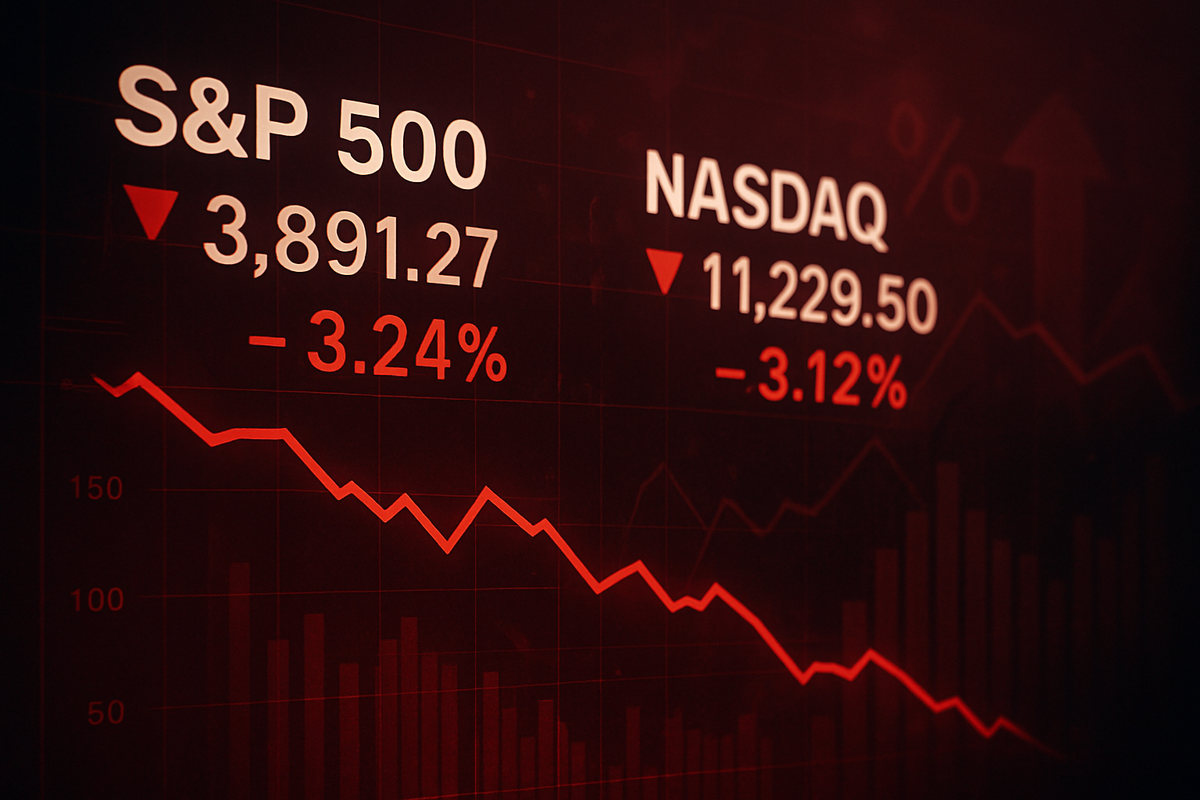Market Tremors: S&P 500 and Nasdaq Slide Amidst Economic Headwinds

November 11, 2025 - Major U.S. stock indices, the S&P 500 and Nasdaq Composite, experienced significant downturns today, sending ripples of concern through global financial markets. The broad-market S&P 500 witnessed a notable decline, mirroring a sharper fall in the tech-heavy Nasdaq, as investors grappled with a confluence of economic uncertainties and shifting sentiment. This market retreat signals a cautious re-evaluation of risk, with immediate implications for investor confidence and the near-term economic outlook.
The day's trading activity underscored a growing unease regarding the trajectory of inflation, the future of interest rates, and the sustainability of corporate earnings. The immediate fallout saw a broad sell-off across various sectors, particularly impacting growth-oriented technology firms that have largely driven market rallies in recent years. Analysts are pointing to a combination of macroeconomic pressures and specific industry headwinds as the primary catalysts for today's market tremors, suggesting a potentially turbulent period ahead for equities.
Unpacking Today's Market Retreat: A Confluence of Factors
Today's market slide was not an isolated event but rather the culmination of several brewing concerns that reached a tipping point. The downturn was largely triggered by a series of economic data releases and central bank pronouncements that fueled investor anxiety. Reports indicating higher-than-anticipated inflation figures for October, coupled with hawkish commentary from Federal Reserve officials hinting at a prolonged period of elevated interest rates, sent a clear signal that the era of cheap money might be drawing to a close.
The timeline of events leading up to this moment began earlier in the week, with preliminary economic indicators suggesting a slowdown in manufacturing output and a slight uptick in unemployment claims. These data points, while not catastrophic in isolation, contributed to a narrative of economic deceleration. Key players, including the Federal Reserve and major financial institutions, have been closely watched, with their communications shaping market expectations. The initial market reaction was swift and decisive, with trading volumes surging as investors moved to de-risk portfolios. Growth stocks, particularly those in the technology sector, bore the brunt of the selling pressure, as their valuations are often more sensitive to interest rate fluctuations.
Winners and Losers: Navigating the Downturn
The market's sharp decline today has predictably created a distinct divide between potential winners and losers. Sectors heavily reliant on consumer spending and high growth projections, particularly in technology, are facing significant headwinds. Companies like Apple (NASDAQ: AAPL), Microsoft (NASDAQ: MSFT), and Amazon (NASDAQ: AMZN), which are major components of the Nasdaq, likely saw their share prices decline as investors reassessed future earnings potential in a higher interest rate environment. Similarly, companies within the consumer discretionary sector, such as major retailers and travel operators, are vulnerable to reduced consumer confidence and spending.
Conversely, traditional safe-haven assets and sectors perceived as defensive could see relative strength. Companies in the utilities sector, consumer staples, and healthcare tend to be less volatile during market downturns as demand for their products and services remains relatively stable. Furthermore, a flight to quality could benefit government bonds and gold, drawing capital away from equities. Financial institutions, while initially impacted by broader market sentiment, might also see opportunities in a tighter credit environment, though increased default risks remain a concern. Energy companies, such as ExxonMobil (NYSE: XOM), could also experience demand fluctuations as economic growth forecasts are revised downwards.
Broader Implications: A Shift in the Economic Landscape
Today's market movements are not merely a blip but rather a potential indicator of a significant shift in the broader economic landscape. The emphasis on inflation and interest rates suggests that the market is grappling with the transition from a period of expansive monetary policy to one of tightening. This event fits into broader industry trends of re-evaluating aggressive growth strategies, particularly in the tech and AI sectors, where valuations have soared. The potential ripple effects on competitors and partners are substantial; smaller, less established firms that rely on venture capital or easy credit may find funding more challenging.
Regulatory bodies and policymakers will be closely monitoring these developments. A sustained market downturn could prompt discussions around fiscal stimulus or other interventions to stabilize the economy, though the current inflationary environment limits the scope for such measures. Historically, periods of rapid interest rate hikes have often preceded economic slowdowns or recessions, offering a cautionary precedent. Comparisons to previous market corrections driven by similar factors, such as the early 2000s tech bust or periods of aggressive Fed tightening, provide valuable context for understanding the potential long-term implications.
What Comes Next: Navigating Uncertainty
Looking ahead, the short-term outlook for the S&P 500 and Nasdaq appears challenging, with increased volatility and further price corrections remaining distinct possibilities. Investors will be closely watching upcoming inflation reports, unemployment figures, and, crucially, the Federal Reserve's next policy meetings for any signs of a shift in stance. Companies may need to implement strategic pivots, focusing more on profitability and cost control rather than aggressive expansion, especially those in high-growth sectors. This could lead to a period of consolidation and rationalization within industries that have seen rapid growth.
In the long term, this market adjustment could present both challenges and opportunities. For cautious investors, a downturn offers potential entry points into fundamentally strong companies at more attractive valuations. However, the path forward is fraught with uncertainty, including the risk of a deeper economic recession if inflation proves persistent and central banks are forced to maintain a restrictive monetary policy for an extended period. Potential scenarios range from a relatively quick market rebound if economic data improves and the Fed signals a more dovish stance, to a prolonged bear market characterized by sustained economic contraction and tighter financial conditions.
Comprehensive Wrap-up: A New Era of Market Prudence
Today's market slip serves as a potent reminder of the inherent volatility and cyclical nature of financial markets. The key takeaway is a clear shift in market dynamics, moving away from an environment that heavily favored growth at any cost, towards one that prioritizes fundamental strength, profitability, and prudent financial management. The S&P 500 and Nasdaq's declines underscore the market's sensitivity to macroeconomic indicators, particularly inflation and interest rates, which are now firmly in the driver's seat of investor sentiment.
Moving forward, investors should brace for continued uncertainty and potential headwinds. The era of easy money appears to be receding, ushering in a period where careful due diligence and a focus on resilient business models will be paramount. What investors should watch for in the coming months includes further inflation data, central bank communications, corporate earnings reports for signs of resilience or weakness, and any shifts in geopolitical stability. The market is entering a new phase, demanding greater prudence and a more selective approach to investment.
This content is intended for informational purposes only and is not financial advice



